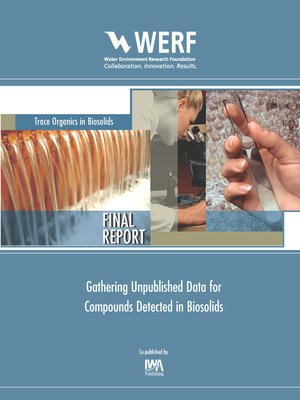Gathering Unpublished Data for Compounds Detected in Biosolids
ebook ∣ WERF Research Report
By Charles Pittinger

Sign up to save your library
With an OverDrive account, you can save your favorite libraries for at-a-glance information about availability. Find out more about OverDrive accounts.
Find this title in Libby, the library reading app by OverDrive.



Search for a digital library with this title
Title found at these libraries:
| Library Name | Distance |
|---|---|
| Loading... |
Available as eBook onl.
The Water Environment Research Foundation (WERF) commissioned a study to assemble high quality, unpublished data on 61 trace organic chemicals (TOrCs) detected in biosolids. The chemical classes of the TOrCs included antibiotics, steroids, hormones, organotins, surfactants, organosiloxanes, fragrance raw materials, antimicrobials, and alcohol ethoxylates. Data on physical-chemical, environmental fate, ecotoxicology, and mammalian toxicology endpoints were compiled by queries of 48 electronic databases, and by broad communications with corporations, trade associations, water and wastewater utilities, and regulatory authorities.
A substantial volume of unpublished (or recently published) experimental data was collected. Of the 61 TOrCs evaluated, mammalian toxicology data and pharmacological data that can be used to derive human health benchmarks were identified for 29 of the TOrCs. Empirical data for the physical-chemical, environmental fate, and ecotoxicological endpoints were less abundant; however, estimates predicted by structure-activity modeling were more readily available for these endpoints. This investigation identified numerous outstanding data gaps for the 61 TOrCs. Recommendations on how to fill the remaining data gaps are proposed through read-across and derivation approaches.
The Water Environment Research Foundation (WERF) commissioned a study to assemble high quality, unpublished data on 61 trace organic chemicals (TOrCs) detected in biosolids. The chemical classes of the TOrCs included antibiotics, steroids, hormones, organotins, surfactants, organosiloxanes, fragrance raw materials, antimicrobials, and alcohol ethoxylates. Data on physical-chemical, environmental fate, ecotoxicology, and mammalian toxicology endpoints were compiled by queries of 48 electronic databases, and by broad communications with corporations, trade associations, water and wastewater utilities, and regulatory authorities.
A substantial volume of unpublished (or recently published) experimental data was collected. Of the 61 TOrCs evaluated, mammalian toxicology data and pharmacological data that can be used to derive human health benchmarks were identified for 29 of the TOrCs. Empirical data for the physical-chemical, environmental fate, and ecotoxicological endpoints were less abundant; however, estimates predicted by structure-activity modeling were more readily available for these endpoints. This investigation identified numerous outstanding data gaps for the 61 TOrCs. Recommendations on how to fill the remaining data gaps are proposed through read-across and derivation approaches.







